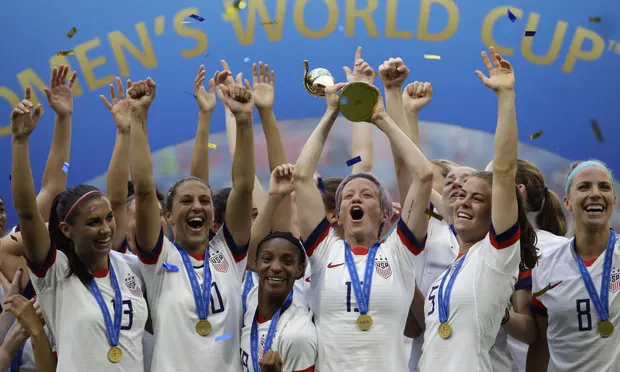USA still world leaders in women’s football despite England closing gap
USA still world leaders in women’s football despite England closing gap: The words “European v world champions” appear over the screen midway up the stands at Wembley.
Sally Yates’s report on abuses in American women’s football has cast a shadow over the buildup to England’s match against the United States, as it should have done, but the story of the game itself is tremendously fascinating.
For many years, American women’s football has been the best in the world. As a whole, we’ve lagged far behind, but we’re starting to catch up.
Statements
On Thursday, Megan Rapinoe said, “there isn’t really a large gap anymore and there hasn’t been for a long time.”
However, why has a void persisted for so long despite the fact that investment in England has increased over time?
The United States has been in the forefront for a number of reasons. In 1972, as a part of the Civil Rights Act Amendments, Title IX was enacted, making important strides in eliminating discrimination against women in the educational system.
Title IX mandated that schools receiving federal funding could not have sex discrimination policies in place. To maintain substantial financing for essential men’s sports like American football and basketball, universities and colleges had to rebalance their funding of sports programs.
Since players from the United States and all over the world can earn scholarships to play at the highest level of college football without having to sacrifice their education, this has resulted in a player pool that is the envy of the rest of the world.
In its place, the traditional English culture of thankfulness has given way to one of competition and high expectations. In the United States, women have the legal right to play football and the expectation that the sport would be adequately sponsored.
This foundation of skill and support has allowed the US women’s national team and the numerous professional leagues to flourish over the years, but as recent investigations have shown, the system is far from ideal.
Without having to compete for attention with the men’s game, women’s football in the United States may flourish. Since football is not the most popular sport among males, there has been room for the development of the women’s game.
Seven members of the English squad, including manager Sarina Wiegman, have played in the United States and can attest to the unique challenges that the country presents to international players.
Declarations
With his signature sardonic grin, Wiegman added, “I was there for one year, a long time ago, as I’m extremely old.” For me, it was a turning point in my life.
We were surrounded by first-rate sporting facilities. What a wonderful experience! This winning attitude was palpable. That happened when I was 19 years old. Since my time in the Netherlands was so enjoyable, I’ve often wished for a return trip to the country with similar amenities and atmosphere. Because of this, I believe it contributed to who I am now.
Lucy Bronze, who, like Wiegman, played for legendary UNC coach Anson Dorrance, remarked, “I think it had probably one of the biggest influences at a critical period in my career.”
When I was a kid, women’s football wasn’t really a big deal in Europe. In contrast, life in the United States was incredible. Having the opportunity to spend a year playing at a college helped me confirm that this was really the path I wanted to pursue.
“It had a great impact on me as a player and a person to play with the players there who went on to be so successful at such a young age, at 17. I credit my mental development in England to having been exposed to their mindset at the tender age of seventeen.
The young Tobin Heath faced off against Bronze there. Bronze recalled, “Tobin had broken into the US team and was the first person that I truly played with that was that world-class caliber and I got to go head-to-head, literally head-to-head with her in training sessions.”
Remarks
As a result, “I knew that I need to work a lot harder and push myself if I want to compete against those kinds of players.”
Women’s teams in Europe and everywhere across the world, both at home and abroad, have struggled to find a means to build a foundation that can compete with the United States system, which fosters player development and produces a large enough pool from which the best may be selected.
The Football Association’s Gameplan for Growth, released in 2017, marked a shift in perspective toward this style of thinking about the game in England.
The plan aimed to strengthen the sport’s foundations in addition to its elite levels. From grassroots and school football to the England pathway and the fandom, all have benefited from more funding and effort.
The success of the Lionesses at the European Championships this summer depends on this effort. To compete with the United States, England now has a depth not seen in the country previously, and young players can enter professional leagues.
There is still a large chasm. You can’t say it’s over until England beats the United States in a World Cup. Still, it will take a long time to build a talent pool on par with the one the US collegiate system delivers.

